|
| |
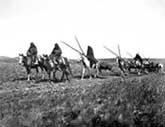
Piegan horses and travois, 1900.
Image courtesy of Glenbow
Archives NA-1700-142. |
| |
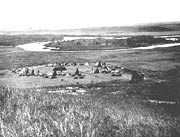
|
| |
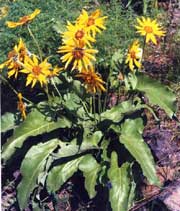
Arrowleaf balsamroot
K. Lugthart photo |
| |
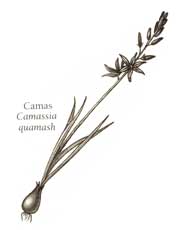
© Lynn Kitagawa
used with permission |
| |
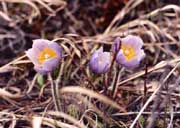
Pasque flower
K. Lugthart photo |
| |

Blooming prickly pear.
Image
courtesy of K. Furrow. |
| |
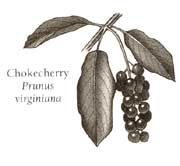
© Lynn Kitagawa
used with permission |
| |
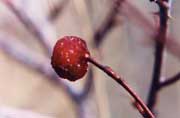
Rosehip
K. Lugthart photo
|
|
|
Great Falls > Culture > Camp Life & Seasonal Round
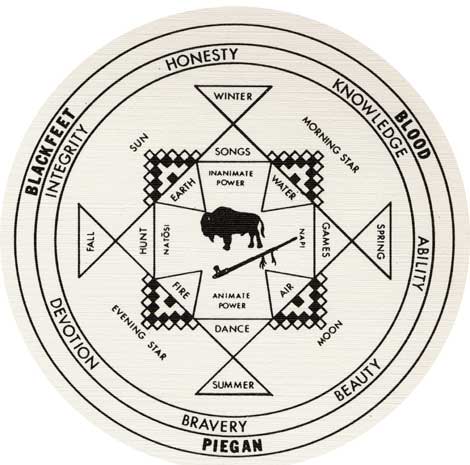
©Jackie Parsons- used with permission
Don Parsons- artist
The yearly cycle of the Blackfeet is divided into four seasons. In
the days when buffalo still roamed the land, patterns of movement reflected
the location of important foods. The buffalo was most important, but
particular camp locations were selected with other resources in mind
as well. To an observer, the changes in camp locations through the
year may appear random, but they were far from that. Each location
was known for the resources it held, whether they were plant, animal,
or mineral, and year after year, the people returned to these locations.
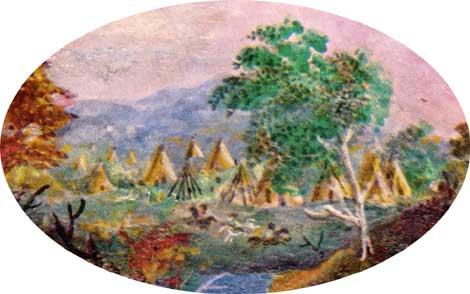
Piegan encampment (Point, 1846)
used with permission from Loyola Press
The work of moving
camp was the responsibility of the women. When the head
chief decided to move camp, that evening the camp-crier would announce
that in the morning everyone should be all ready to leave. The
women were up at dawn preparing the family breakfast, finishing
packing, and tying the family belongings to the horse travois.
| Women would take down their hundred pound buffalo skin lodges
and tie them between the horse's horned saddle. Two horses were
needed to pack the nineteen lodge poles. Women packed saddle bags
filled with dried meat and berries, tallow, and tobacco, and they
packed bedding, tools, utensils, and ceremonial objects to be carried
on the travois. Babies rode on their mother's back while
the toddlers rode upon the travois. Older boys took care of the
loose horses. |
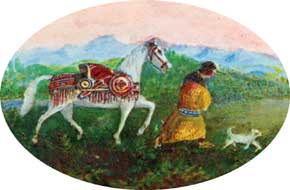
"The horse that carries the calumet on the march
is exempt from all other use and she who leads him is the most
honored woman of the tribe" (Point, 1846). -used
with permission from Loyola Press
|
The day's long journey would end with enough sunlight
so the women could unpack, erect lodges, cook supper, and then prepare
for the next day. Children helped gather wood and bring water. When
wood was low, women used dried buffalo chips and dried grass for fire
(Summarized from Ewers 1958:92-93).
|
| |
| Spring |
| |
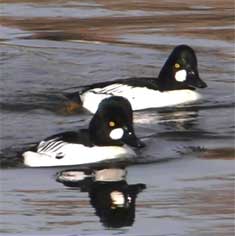
Goldeyes
K. Furrow photo |
When spring comes, life awakens and the beauty of green
life can be seen again. Spring arrives just after the moon "when
the ice breaks up" (in April), during the moon "when the geese
come" or "when the leaves are budding" (in May) and after the
first thunder is heard. This marks the end of the storytelling
season.
|
In buffalo days, when the buffalo plant was in flower and the buffalo calves
were yellow, it was time to leave the long camps of winter. Before they
left camp, just after the snow disappeared, the ground of the tobacco garden
was prepared for planting. The seeds would grow while they were off hunting
the buffalo. Some of the important men who were responsible for the well-being
of the tobacco, would return to the garden to tend the plants several times
during the growing season. At the right time, everyone would gather near
the garden for harvesting the tobacco in a ceremonial manner.
Extended family groups would split apart to follow the
buffalo and other game out onto the grassy plains, always choosing
campsites near potable water and firewood. Everyone anticipated
the great variety of fresh foods of spring after eating dried meat
and berries most of the long winter. Great spring feasts included
eggs of ducks and other water-fowl, "pomme blanche," wild
turnip, and roasted camas bulbs.
|
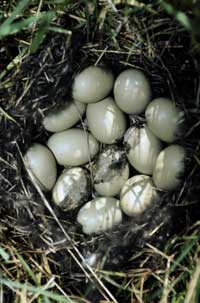 Duck nest
Duck nest
N. Dakota Game & Fish |
|
| |
| Summer |
| |
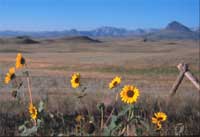 Wild sunflowers
Wild sunflowers
S. Thompson photo |
The buffalo migrated to the open grassy plains in the
early summer, the time known to the Blackfeet as the "moon of
flowers."
The people followed the buffalo to the Cypress
Hills or other hunting grounds in the eastern region of their homeland
where they would stay only as long as the buffalo. The summer
hunts
provided the ceremonial buffalo-bull tongues needed for the Medicine
Lodge, or Sun Dance Ceremony, during the moon when "serviceberries
were ripe".
|
After the Sun Dance, the chief would tell his people it was time to move
to "Many-berries" or other places rich in fruit. The women would gather
sarvis berries every other year, when there was a crop. They collected
branches, which they beat over a buffalo robe. The berries were dried and
stored for future use. Goose berries and red willow berries were also collected
in late summer. The people would move from place to place either because
it was a good location for picking berries or a good place to hunt bulls. |
| |
| Fall |
| |
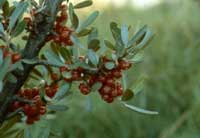
|
Buffalo berry
|
Dave Ode photo
|
|
At the time when "leaves are yellow and the time of first
frost" the chief would announce that it was time to move to where
the choke-cherries were ripe. The women would pick the fruit,
then
pound it with a stone maul, pits and all, and then dry it. This
was usually mixed into soup or with pemmican. Bull berries, a
favorite
fruit, were ripe at the same time.
|
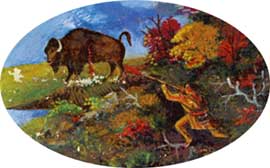
"For the superior hunter, the best weapon was
the rifle" (Point, 1846).
used with permission from Loyola Press
|
About the time "when the geese fly south" was the most
important buffalo
hunt of the year. The fall was also a time to go to the
hills and mountains for lodge poles. While men were busy with their
activities, the women processed meat and berries and made pemmican
for the winter. Robes were also prepared for trade.
|
Once the white traders were established in Blackfeet country, the men hunted
for wolves, badgers, skunks, antelopes, and buffalo at this time of year so
they would have hides and pelts to trade. The trading fort was part of their
seasonal round, and they all looked forward to the goods that would be acquired
through trade. |
| |
| Winter |
| |
Winter camp locations were scouted out in October or
November. The head chief would consider the information from the
scouts, then,
with the advice of the band chiefs, select a location that fit
the needs of the tribe. The ideal locations were in stands of
trees
in protected valleys, where people were sheltered from the snow
and cold winter winds. Camps were arranged along rivers for fresh
water and where firewood could easily be found to keep the lodges
warm. The buffalo wintered in the valley bottoms, along with the
Blackfeet, who gathered in large numbers during this season.
|
 Old Cabin on Two Medicine River
Old Cabin on Two Medicine River
S. Thompson photo |
At this season, buffalo were prime and fat. Full tribal participation
was needed to conduct a successful hunt and to acquire the winter supply
of buffalo meat. Hunting continued into the moon "when the buffalo calves
are black" and the heavy snows come (in January). When the fresh food
was consumed, people lived off of the dried meat and berries preserved
during the previous months.
Winter days were long and provided a time for the nomadic buffalo followers
to rest and play and pass on traditional stories. Camps were large and
much socializing occurred. The winter was a time for children up to sixteen
years of age to play and compete against each other in traditional winter
sport games, including coasting, top-spinning, sliding on ice, and other
children's games.
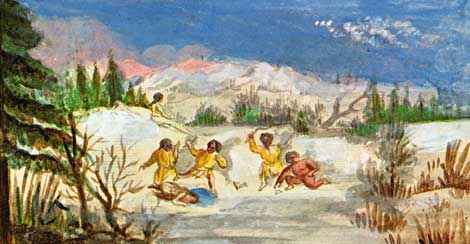
"Favorite pastimes of children playing on ice were sliding
or a game called spinning tops." (Point, 1846) used with permission
from Loyola Press On cold, windy nights the children would sit around the warm tipi lodges
and listen to the elders recount the beautiful myths, legends, and stories
of their tribe. The elders would tell the children about their brave Blackfeet
warriors who had many encounters in war against their enemies. Other stories
of exciting hunting trips would help pass the long winter months.
Elders' stories taught how to look into the future by observing the warnings
of animals, and how to know the different moons by watching the changes
of the seasons and by studying the habits of birds and wild animals, and
to know the signs in the heavens.
The most popular of winter sports was coasting down steep, snow-packed
hills onto the valley bottoms. The sleds that were used for coasting were
made without a single nail or bolt. They were made entirely of parts of
the buffalo carcass. The runners were five to ten buffalo rib bones; the
long, heavy ribs of a buffalo cow, scraped free of meat and gristle. These
ribs were separated from the backbone and breastbone and reassembled in
exactly the same order they had appeared on the buffalo. The ribs were
tied together at each end by a rawhide rope that wound in and around a
cross-piece of split willow. The seat was made of skin from the leg of
the buffalo, stretched hair-side up over the runners and tied to the willow
cross bars at each end. A buffalo tail was sewn or tied to the rear of
the seat for decoration. A rawhide rope was tied to the front to pull the
sled uphill and to guide it sliding downhill (Ewers: 1945).
The people have always understood winter as the time for death, when that
spirit from the north blows onto the Mother Earth its power, the snow.
All of the beauty of the Mother Earth is covered over by the snow white
blanket of the northern spirit. Underneath this blanket all life goes to
sleep as though they were dead (Floyd Rider, 1994). All winter long the
Beaver Bundle holders notched into their calendar sticks the passing of
each day, keeping track of the right time for their spring Beaver ceremonies.
|
| |
Background: Rocky Mountain Front, near Skunk Creek. K.
Lugthart photo
|
|
|
|





















